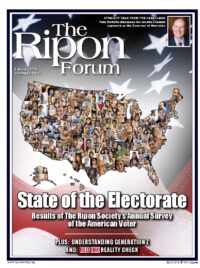
About two years ago, I noticed I was much happier going to class than I had been in quite a while. At first, I wasn’t sure why. Then it dawned on me. The Millennials were on their way out, and a new generation, Generation Z, was on their way in.
I find Generation Z, of which my 16-year-old son is a member, to be far more interesting and engaged students. While they are definitely addicted to their smartphones, they don’t constantly hide behind them and other forms of technology. They talk to each other and even talk to me before class begins. They ask questions all class long and stay after class to ask even more questions. They listen and they laugh at my corny jokes. And they are not just looking out to get something for themselves. Indeed (a total Gen Z word), class is fun again.
Since my professional epiphany, I have been studying Generation Z, which is generally considered to be ages 22 and younger. As a political scientist, naturally my focus has been on their political behavior – although I have also become quite familiar with their other tendencies. I have already been interviewed on my findings thus far by a number of regional and national media outlets, but my study is not yet complete. Since Generation Z has only recently begun to participate in elections, more election cycles are needed to be more conclusive.
Here is a summary of what has been found to this point:
Researchers Corey Seemiller and Meghan Grace surveyed over 1,100 Generation Z students from across the United States (Generation Z Goes to College, 2016). Politically, what they found is very significant. 78% of Generation Z identifies as liberal to moderate on social issues and 83% identifies as moderate to conservative on fiscal issues. To repeat, 78% of Generation Z identifies as liberal to moderate on social issues and 83% identifies as moderate to conservative on fiscal issues.
78% of Generation Z identifies as liberal to moderate on social issues and 83% identifies as moderate to conservative on fiscal issues.
First of all, rarely in Social Science are such definitive tendencies revealed. Second of all, these indicate that Generation Z has strong libertarian leanings, similar to what is found in more moderate Republican circles. While these findings are remarkable, they perhaps are not all that surprising. Generation Z grew up in a time of immense racial and ethnic diversification in the United States, as well as during the rise of LGBT rights. That would explain their more socially liberal views. At the same time, these young people also lived through the Great Recession and a time of perpetual war and terrorist threats beginning with 9/11. These events undoubtedly shaped the more conservative stances of Gen Z when it comes to economic and security issues.
Given these inclinations and their ages, many Generation Z’s are not yet connected to either of the two major political parties. However, as noted above, Gen Z’s inclinations would generally fit that of moderate Republicans, of which notably there aren’t as many in leadership positions anymore. The Republican Party, if it plays it cards right, has a chance to make lasting inroads with this generation, even at an early age. That is something Republicans have struggled with for decades. Democrats on the other hand can’t and shouldn’t take Gen Z’s for granted, as they have with previous young generations, including most recently with the Millennials.
The 2016 presidential election was the first one in which Generation Z voted. Yet, there was virtually no attention paid to this demographic by anyone – not the media, the pundits, the social scientists, the political parties, the candidates, etc. In almost every case, Gen Z was simply lumped with its significantly different counterparts, the Millennials, in the 18 to 29 age group. Looking at the data, there was virtually no attempt to separate these two dissimilar generations of voters. This was very unfortunate as it did not give a true picture of the election.
However, comparing the numbers of the youth vote in the 2012 and 2016 presidential elections, one can begin to surmise the impact of Generation Z. Using data from the Edison Research National Exit Poll (http://www.edisonresearch.com/election-polling/), from 2012 to 2016 the youth vote remained the same 19% of the electorate. The difference was that in 2012 there was essentially no significant amount of Generation Z voters. The youth vote was comprised of almost entirely Millennials. By 2016, a key portion of the youth vote was from Generation Z.
The Republican Party, if it plays it cards right, has a chance to make lasting inroads with this generation, even at an early age.
So then, what ended up being the difference in the numbers from the one presidential election to the next? From 2012 to 2016, Democratic Party identification of the youth vote dropped 7 points (down 44% to 37%). Furthermore, from the one election to the next, the Democratic candidate lost 5% of the youth vote nationally (down 60% to 55%). Many went to third party candidates as the Republican candidates received the same 37% in both elections. But, a closer look at specific swing states that ended up turning the entire election is much more telling. In Florida, the Democratic margin of victory for the youth vote from 2012 to 2016 dropped 16 points. In both Ohio and Pennsylvania, the drop was 19 points. In Wisconsin, it was 20 points. These dramatic declines helped give Republican Donald Trump a win in each of these states, pushing him over the top in the Electoral College. Even in New Hampshire, a state that Democrat Hillary Clinton won, the drop in the Democrat’s margin of victory for the youth vote was 20 points. In Nevada, where Clinton also won, it was 21 points. Clearly, the youth vote had shifted toward the right, particularly in some of the most critical states.
It is highly unlikely that such significant declines in the Democratic margin of victory for the youth vote were simply due to the more liberal Millennial Generation changing their minds from one election to the next. It is much more likely that the precipitous drops were due to the more conservative Generation Z being able, for the first time, to express their political inclinations, especially in economically hard-hit swing states. Some Generation Z voters were likely attracted to the Republican candidate because of Trump’s strong stances on economic recovery and national security – two of the main concerns of that generation. They were also likely to be dissuaded by the apparent lack of transparency and accessibility of the Clinton campaign. According to Seemiller and Grace’s study, those are traits that Gen Z demands in leadership, which Trump seemingly possessed during the election with his “tell it like it is” style.
Therefore, Generation Z possibly had a major, yet completely overlooked, impact in the historic 2016 presidential election. Just as importantly, the media, pundits, academics, political strategists of both parties, and pollsters need to recognize and respect this new generation of voters. In the upcoming election cycles, Generation Z will continue to be a larger and larger proportion of the youth vote. Eventually, they will make up the entire youth vote. So the time is now to start paying proper attention to Generation Z and their politics.
Jeffrey M. Brauer is a professor of political science at Keystone College.




